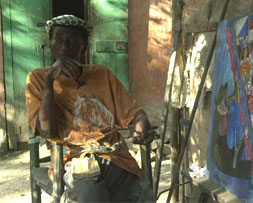Ha itian art, culture, literature, and music have evolved into dizzying mixtures of Caribbean, Cuban, African, indigenous, and European influences. Despite Haiti’s long suffering in most areas of human experience, it has managed to develop and sustain strong traditions in the visual arts, literature, and music, and a number of present-day artists and gallery owners are working to preserve and extend its cultural legacy.
itian art, culture, literature, and music have evolved into dizzying mixtures of Caribbean, Cuban, African, indigenous, and European influences. Despite Haiti’s long suffering in most areas of human experience, it has managed to develop and sustain strong traditions in the visual arts, literature, and music, and a number of present-day artists and gallery owners are working to preserve and extend its cultural legacy.
The most well-known Haitian style of painting, the “naïf” or “naïm” style, originated in the mid-1940s, when American-born teacher Dewitt Peters opened the Centre d’Art in Port-au-Prince. The intense, saturated style is today most commonly associated with Hector Hippolyte, who painted scenes of vodou ceremonies and spirits. Today’s Haitian painters have both extended and reacted against this school; in 2004, painter Patrick Nal Boucard founded an art gallery and film festival in the southern coastal city of Jacmel, expressly dedicated to preserving Haiti’s artistic heritage.
There has always been intense interest among collectors in the visual artifacts of vodou, especially the ornate ceremonial flags. The “vodou blacksmiths” of Croix des Bouquets, including sculptors Gabriel Bien-Aimé and Serge Jolimeau, create intricate and startling metal drum sculptures inspired by vodou mythology.
Before the beginning of the 20th century, Haitian literature was written almost exclusively in French. Notable writers include Jean-Price Mars (whose work inspired Duvalier) and Jacques Roumain, whose GOUVERNEURS DE LA ROSEE (MASTERS OF THE DEW, 1947) is considered a classic. In the mid-century, authors like Félix Morisseau-Leroy pioneered the use of Creole in literature and the performing arts. His seminal work was a Creole version of Sophocles’ play, “Antigone,” performed in 1953. Poet Rene Depestre has lived in exile, first in Cuba and now in France. Contemporary Haitian and Haitian American authors write in Creole, English, and French. Today, the Haitian diaspora’s two most prominent writers are novelists Dany Laferrière and Edwidge Danticat; both have drawn heavily on Haitian history, culture, and traditions in their work.
Haitian music bears evidence of French colonizers, the West African slaves who brought vodou to the island, and rhythms from elsewhere in the Caribbean and the Americas. Ra Ra music, played during vodou carnival celebrations, has been mixed with reggae, rock, and elements of funk to produce Rasin or Roots music, known for its politicized lyrics and driving beats. Roots practitioners include singer/songwriter Manno Charlemagne and the band Boukman Eksperyans, named for a 17th-century revolutionary leader. Their 1990 carnival song “Keím Pa Sote” (I’m Not Afraid) was chanted in protests against Haitian dictator Prosper Avril. Compas and Zouk, genres mixing Creole song forms with meringue, rhumba, and mambo rhythms, have long been popular; Tabou Combo are the most visible exponents of zouk. A younger generation of Haitian musicians has turned their efforts to hip-hop; Haitian-American producer, musician, and activist Wyclef Jean is perhaps the most visible (and has recruited Haitian musicians to play on his recent recordings); younger hip-hop musicians include Freedom (Christopher LaRoche) and Baby One King (Ralph Michel), who provided the music for “Unfinished Country.”


